- This is part two of this profile. Read part one here.

Jim Hansen giving testimony at a US Congressional hearing in 1988, where he’d declare 99% certainty that humans are changing the climate. Image credit: NASA
“It’s time to stop waffling so much and say that the evidence is pretty strong that the greenhouse effect is here.” It’s a comment that wouldn’t sound out of place today, but Jim Hansen made it 26 years ago, on June 23, 1988, amid record 38°C temperatures in Washington DC. Jim said it to reporters after telling a Congressional hearing he was 99% certain the world is getting warmer thanks to human-made greenhouse gases.
Jim’s 1980s media bombshells led journalist Robert Pool to liken him to a religious ‘witness’, ‘someone who believes he has information so important that he cannot keep silent’. However, he still felt shy and awkward, preferring to immerse himself in pure science, and so would turn down almost all invitations to speak out for another decade. Jim’s efforts during that period would then help build even stronger evidence on global warming. But with extra motivation provided by clashes with the US government and the arrival of his grandchildren he would return to bear witness more forcefully than ever.
Before his self-imposed media ban Jim would make headlines one more time in 1989, after giving written evidence to a hearing convened by then US senator Al Gore. The testimony reaching the hearing had been altered by the White House to make his conclusions about the dangers of global warming seem less certain. When Jim sent the future vice-president a note telling him this, he alerted the media, turning their scheming into the lead story across all TV networks that evening. John Sununu, aide to then president George H. W. Bush, would then try to get Jim fired for his troubles. But Republican senator John Heinz intervened on Jim’s behalf, and he kept his job.
The reputation Jim had built up as a warming witness went ahead of him in December 1989, as he walked into a ‘roundtable’ meeting held by senators Al Gore and Barbara Mikulski. On the coldest day of the year, in a building whose heating system had failed, Al noticed Jim enter and said, “Hey, aren’t you the guy who…” Despite such jibes, Jim was becoming firmer in his convictions. In April 1990 he offered a group of climatologists an even money bet that one of the next three years would be the warmest in a century. He’d be proven right by the end of the year.
Abrupt eruption
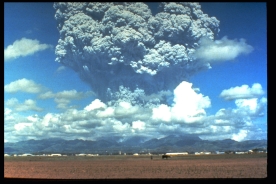
Mount Pinatubo erupts in 1991, sending dust and gas into the air that would cool the planet for following next two years. Credit: USGS/Cascades Volcano Observatory
The Earth’s hot streak abruptly reversed when Mount Pinatubo, in the Philippines, erupted in 1991. Having deeply studied the dust and gas volcanoes throw into the air Jim expected the cooling. Likewise, the climate models he’d helped develop at NASA Goddard Institute for Space Studies (GISS) would help him predict how long it would last. His team simplified the GISS model so they could run hundreds of different experiments quickly, and collected measurements on many important parts of our climate. Using the model and data on aerosol particles in the stratosphere, 10-50 kilometres above Earth’s surface they predicted the world would cool for two years before warming again. That’s just what it did.
Jim returned to the limelight in 1998 in public climate change debates against contrarian scientists Richard Lindzen and Pat Michaels. Jim and Richard crossed swords again after George W. Bush became president in January 2001. He had beaten Al Gore in part by promising to restrict power plant emissions. Within two months the new government would start going back on that promise, the president writing in a letter that the greenhouse gas CO2 wasn’t a pollutant. In the exchange that revealed this U-turn, four senators quoted one of Jim’s papers in support of the idea that the CO2 problem was overstated. In fact, although the study found cuts in other warming pollutants might reduce the chances of dangerous climate change, it also demanded that growth in CO2 emissions should slow.
Vice-president Dick Cheney’s ‘climate task force’ invited Jim and Richard to inform them about global warming and humans’ role in it. As well as laying out the evidence, Jim tried to highlight that Richard’s earlier comments disputing the greenhouse effect’s significance were by now clearly wrong. Richard parried by claiming he had been misquoted, and went on to focus heavily on the uncertainty in existing climate research. Jim later heard that afterwards the vice-president and his fellow politicians couldn’t judge which of the contrasting viewpoints to believe. Later still, he asked Richard about the link between smoking and cancer, and the answer filled him with regret. It was so similar to Richard’s position on climate that if he’d asked it in front of the task force they might have taken a very different view on his credibility.
Back to school
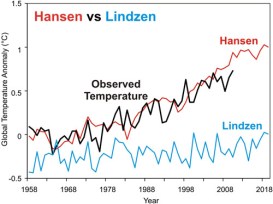
A reconstucted graph by Skeptical Science comparing measured warming (black) with what Jim Hansen (red) and Richard Linzen’s (blue) 1988 and 1989 positions would have projected had they been able to precisely forecast the greenhouse gas emissions since. Jim Hansen’s line is based on a 1988 modeling study and Richard Lindzen’s is based on statements from his talk at MIT in 1989. Jim’s global temperature changes predicted in 1988 have proven quite accurate. Image credit: Skeptical Science
Feeling bruised after the confrontation, Jim started to think how he might have got his message across better. The answer, he realised, might come from a group including schoolchildren – some from minorities or disadvantaged backgrounds – students, teachers and professors. The group was an education program called the Institute on Climate and Planets (ICP) Jim and his colleague Carolyn Harris had set up in 1995. Each summer the ICP would tackle a research problem set by Jim. After the 2001 climate task force meeting Jim asked: how would you brief the vice-president on how to reduce CO2 emissions while ensuring enough energy to drive economic growth?
In the course of this work, Jim was invited to talk to top car company executives and engineers, at Exxon/Mobil. After his talk, he stayed to listen to the rest of the meeting, which involved lots of criticism of the California Air Resources Board (CARB) plans to improve vehicle efficiency. When Jim asked why they didn’t just make more efficient cars rather than fight CARB, they responded ‘we have to give customers what they will buy’. But when Jim got home and saw adverts for cars unrealistically driving up mountains, he wondered whether that demand really originated with the customer.
This encounter fed into the ICP team’s work, and they suggested that improvements in vehicle efficiency should be a key part of the plan. Ultimately they found existing technology could limit warming to 1°C from the year 2000’s temperature. Jim wrote the paper describing their findings in an unusual style, a story in which they really did share their findings with the vice-president. Yet even in that fictional world their proposed plan wasn’t adopted.
In December 2001, the magazine Scientific American commissioned Jim to do a 3,500 word piece to bring the climate crisis to a broader audience. However, word progress faltered because editors wanted him to focus on models and the work of the UN Intergovernmental Panel on Climate Change (IPCC). Jim himself preferred to use evidence of climate change from historical and modern data before bringing in models. He also disagreed with the IPCC’s findings at the time that warming had to reach 3°C before it would be dangerous – he thought 2°C would be a disaster. Frustrated with the changes his editor wanted, Jim withdrew the article and published it himself on the web.
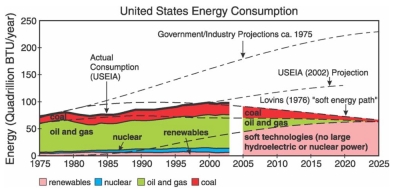
The graph Jim Hansen used to lay out the problem facing government to his ICP team. This version comes from Jim’s 2004 draft of the resulting paper, and uses US Energy Information Administration (USEIA) data. The projected “business as usual” path would put the world on the course for dangerous climate change. He asked his team: Can we find a lower energy use scenario, like the one Amory Lovins came up with in 1976, that a government might adopt? Image credit: Jim Hansen
When Jim was again invited to address officials at the White House in 2003 he’d combine insights from both the article and the ICP project. His talk, “Can We Defuse The Global Warming Time Bomb?”, combined the Scientific American evidence with the ICP’s positive message that it was still possible to halt global warming. But he would be again followed by another talk from Richard Lindzen the next week. The president would then not ask for further scientific advice on climate change during the rest of his time in power.
Jim then gave a similar presentation to NASA administrator Sean O’Keefe, a friend and protégé of Dick Cheney. Sean suggested Jim shouldn’t use the word ‘dangerous’ about human effects on climate, because we did not understand climate well enough to know what constituted danger. Though Jim feels he probably should have disputed that, he didn’t and although it was a brief, calm, discussion, the message was crystal clear. It got Jim thinking: The UN had used the word in the Framework Convention on Climate Change – why hadn’t scientists paid more attention to it?
Focussing largely on the world’s ice sheets, Jim would therefore tackle the question himself. He realised that the IPCC estimates for sea level rise at the time didn’t include any contribution from Greenland or Antarctica. That made the chances of a 1-2m sea level rise that would be disastrous for millions of people across the world much higher. He stressed that point in the updated ‘Time Bomb’ article Scientific American finally published in 2004 and a partner essay mostly written during a six-hour wait for a flight in Munich.
Yet when it came to making this argument in public debate, Jim would again fail. A year later a carmaker’s lawyer fighting the CARB rules asked him to name a glaciologist who would agree greenhouse gas emissions would cause a metre of sea level rise. He couldn’t. He became increasingly aware of what he’d later call ‘scientific reticence’ – a fear of crying wolf ingrained in scientists trained to be objective and sceptical. Had reticence – his own, and that of others – held him back when faced with lawyers, vice-presidents and NASA administrators?
A grandfather’s struggle against censorship
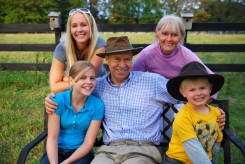
Jim Hansen with his wife Anniek, daughter Christine and grandchildren Sophie and Connor. The idea of his grandchildren thinking in future ‘How could they be so stupid’ motivated Jim to speak out, risking his career. Image credit: JIm Hansen
He felt that if scientists didn’t stand up future generations – including his grandchildren, the eldest of whom was now five – would ask why they had been so stupid. He had again stopped giving public talks because he often found his brain ‘froze up’, but that excuse seemed ever poorer. So when he was invited to become a director of and speak to an organisation called Environment 2004, he was tempted to make a public pronouncement. However, as it aimed to help defeat George Bush in the next election by highlighting environmental issues Jim, a registered independent voter, preferred not to participate.
Although the invitation had made Jim realise he needed to say someting before the next election, it wouldn’t be easy to find another chance. The organisation he first tried to go through at first delayed and then withdrew. And then suddenly problems at his work, NASA GISS, made the need to speak out even more urgent. A press release on climate research had been held up for a month, thanks to a new NASA process that had anything related to global warming stuck in gridlock. It emerged that everything was being sent to the White House, where they were held up and edited. “It seemed to me that NASA’s Office of Public Affairs had become its Office of Propaganda,” he later wrote.
Finding it hard to sleep, Jim sat up one night writing a letter to his former University of Iowa mentor James Van Allen, by then aged 90. He explained his experiences with the government, the seeming censorship, and suggested a talk at the university. Because of its potential political sensitivity, Jim stressed he’d be giving it as a private citizen, and would cover his own travel costs. Thanks to his pioneering astronomy work James’ opinion still carried weight locally. He’d once sat on a microwave while it was cooking to play down safety concerns, which had settled the matter for most people. With help from James’ legendary status, Jim would give a ‘distinguished lecture’ on October 26, 2004.
But the day before the speech he sent the text to New York Times reporter Andy Revkin, who quickly published an article highlighting its criticism of George Bush’s policies. NASA headquarters saw the piece and sprung into action, urging Jim to take out the political elements of his speech. “If the Times article is correct, he is going further than he has in the past, placing himself at considerable personal risk this evening,” an email warned.
Tears of mourning
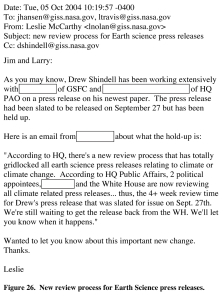
A slide from the talk Jim Hansen gave in Iowa in 2004, where he revealed White House interference in NASA GISS’s efforts to publicise its research. Image credit: Jim Hansen
It was too late for Jim by then. The previous night he’d worked extra late, getting just an hour sleep. On his way home at 4:30am he wondered why he was paying for his own flight and using his precious vacation time to give a talk that would probably have no effect. But the words of Don Hunten, who Jim had worked with to send a probe to study climate on Venus, kept him going. When Jim told Don he wanted to pull out of that project to study Earth instead, Don had just said, “Be true to yourself”. Jim realised that’s what he must do here.
His talk discussed exactly what Sean O’Keefe had told him not to – why human interference in climate is dangerous. Though it felt like an anti-climax for an exhausted Jim, Abigail Van Allen – James’ wife – reassured him that his talk had been good and understandable, but that it would be difficult to get the public to pay attention. Jim and James then talked about their work, though Jim was by now gloomy that he’d get the chance to finish his current projects. It would be the last time the two met. James Van Allen died in 2006.
Abigail Van Allen’s instincts were soon proved right. The coverage Jim’s talk received largely focussed on the strict controls the government was placing on the flow of information from NASA. And so when the presidential election came a week later, and the signs of George Bush’s victory emerged, Jim resolved to drive into GISS to deal with the fallout. As he rounded a curve in his car, Jim suddenly saw a deer, much too late to do anything other than crash into it. They collided, the deer hurtled down the road and then lay motionless, apparently dead. “Then, aged sixty-three, for the first time since childhood, I burst into tears,” Jim wrote. “I am not sure if I was crying for the deer, the nation, or the planet.”
Though Jim could scarcely have felt worse, these events would harden his tenacity even more. His determination would not only preseve his NASA role, it would drive him on to clash with authority ever more regularly, and continue bearing witness even today.
- This is part two of my profile of Jim Hansen. Now read part three.
Further reading:
I’ve already written about the following pivotal climate scientists who came before Jim Hansen, or were around at the same time: Svante Arrhenius, Milutin Milanković, Guy Callendar part I, Guy Callendar part II, Hans Suess, Willi Dansgaard, Dave Keeling part I, Dave Keeling part II, Wally Broecker part I, Wally Broecker part II, Bert Bolin part I, Bert Bolin part II, Suki Manabe part I, Suki Manabe part II, Steve Schneider part I, Steve Schneider part II, Steve Schneider part III, Jim Hansen part I.
I got most of the information for this blog entry from Jim Hansen’s book, ‘Storms of my Grandchildren’. Other details come from Spencer Weart’s interviews with him, conducted in the year 2000 and now hosted by the American Insitute of Physics’ Oral Histories Project. Jim also answered some questions for me by email, though the responses are more relevant to the previous and next instalment of his profile.
Pool, R. (1990). Struggling to do science for society Science, 248 (4956), 672-673 DOI: 10.1126/science.2333515
Staff writer (1990). Watch Out! Here Comes the Greenhouse Science, 248 (4955), 549-549 DOI: 10.1126/science.248.4955.549-b
Hansen, J., Sato, M., Ruedy, R., Lacis, A., & Oinas, V. (2000). Global warming in the twenty-first century: An alternative scenario Proceedings of the National Academy of Sciences, 97 (18), 9875-9880 DOI: 10.1073/pnas.170278997
Hansen J (2004). Defusing the global warming time bomb. Scientific American, 290 (3), 68-77 PMID: 14981880
Hansen, J. (2005). A slippery slope: How much global warming constitutes ‘dangerous anthropogenic interference’? Climatic Change, 68 (3), 269-279 DOI: 10.1007/s10584-005-4135-0
Hansen, J. (2007). Scientific reticence and sea level rise Environmental Research Letters, 2 (2) DOI: 10.1088/1748-9326/2/2/024002
Spencer Weart’s book, ‘The Discovery of Global Warming’ has been the starting point for this series of blog posts on scientists who played leading roles in climate science.


May 17, 2014 at 3:59 pm
The Hansen vs. Lindzen graph is misleading, since it has Lindzen claiming that the temperature in 1958 was 0.4 C lower than it really was. See http://stevengoddard.wordpress.com/2011/04/29/skeptical-science-cheating-4x/ for a list of faults in that graph. Number 3 is the obvious one that anybody can see, and which should raise doubts about the motivation of those who publish such a graph.
May 20, 2014 at 9:42 pm
Thanks for your comment Richard, but it leaves me downhearted that out of the 2000-plus words here, this is what you pick up on. I’d really appreciate it if you could find something positive, or even funny, to soften the blow of the criticism you’re bound to lay on!
Yes, it’s obvious that Richard’s line starts from a lower starting point than Jim’s, but this reflects the claims he was making at the time, that the world hadn’t warmed as much as Jim was stating. The authors of the graph make very clear it’s their interpretation and this doesn’t seem unreasonable to me.
It’s fitting, in a way, that you raise this point. The objection is very similar to Richard Lindzen’s own objections on climate research – a critical one, pointing out what others may have done wrong. If there were any contrarians/sceptics who been anywhere near as successful in making predictions as Jim, there may be some basis in giving them more weight, but there aren’t. Not having made predictions doesn’t boost Richard’s reputation, for me.
Here is a link to how the graph was created with point-by-point rebuttals of Steve Goddard’s comments (comment 28)
http://www.skepticalscience.com/news.php?p=1&t=53&&n=711
May 21, 2014 at 11:13 am
Sorry to be negative, but the different starting point in the graphs really stood out for me, and it’s only by putting a contrary point of view that I learn. I will study your references.
Had a bad headache all last week, so a lot of catching up to do this week. The doctor has prescribed more pills, which I have to pick up this week.
May 21, 2014 at 11:35 am
Sorry to hear you’re not feeling well Richard. I hope you get better soon.
May 21, 2014 at 5:25 pm
OK, let’s take your first reference step by step, and see where it leads us.
“According to the slightly longer temperature record of the Hadley Centre, 1880 was closer to a local maximum than a minimum.”
True for HadCRUT4.2.0.0, and we are talking about global temperatures here.
Lindzen wrong here.
“But more importantly, he is claiming here that the average global surface temperature trend between 1880 and 1989 is approximately 0.1°C.”
HadCRUT4 1880 anomaly -0.079 C
HadCRUT4 1989 anomaly +0.206 C
Difference = 0.285 C = 0.2615 C / century.
Lindzen wrong here.
“In the first figure below, these projections are compared to the average of GISTEMP’s land and land-ocean temperature records, which may be the most relevant for comparison to Hansen et al. 1988. As in Hansen’s original 1988 paper, we begin plotting the data in 1957, and of course as we have previously discussed, GISTEMP is consistent with all the other surface and satellite temperature data sets.”
If they are all consistent, I will continue to use HadCRUT4 which is what Skeptical Science started with, and see where it leads us.
“As you can see, Hansen’s Scenario B is not far from reality, with a warming trend since 1984 (0.26°C per decade) approximately 30% too high (compared to our average GISTEMP trend of 0.20°C per decade), and the adjusted Scenario B even closer, with a warming trend just 17% higher than observed.”
Now we are down to the last 30 years.
HadCrut4 1984 anomaly 0.069 C
HadCRUT4 2014 anomaly 0.652 C
Difference = 0.583 C = 0.1943 C / decade, about 5% lower than their claim for GISTEMP.
So, instead of Hansen’s estimates being 17% and 30% too high, they could be 22% and 35% too high, depending on which global temperature data set is used.
“Additionally, Dr. Hansen’s 1988 climate model was a bit more sensitive to greenhouse gas changes than the models used by climate scientists today, with a sensitivity of 4.2°C for a doubling of CO2. We can further adjust his Scenario B to reflect the IPCC climate sensitivity of 3°C to determine what today’s climate model projections would have looked like in 1988.”
So, if Hansen had made his prediction knowing what we know now instead of what he knew in 1988, he would have been more accurate 🙂
I don’t think Lindzen or Hansen come out of this looking very good.
May 17, 2014 at 4:33 pm
Since Lindzen didn’t actually make any predictions, it is better to compare Hansen’s predictions with reality, as has been done at http://www.acting-man.com/?p=27855
May 20, 2014 at 9:48 pm
Thanks for sharing Richard, but unfortunately Pater Tenebaum’s comments about Jim at that link are based on Jan-Erik Solheim’s flawed 2012 analysis which, among other things, focuses only on CO2 and not other greenhouse gases. See a detailed rebuttal here:
http://www.skepticalscience.com/simply-wrong-solheim-hansen-88.html
I’m not reassured about Tenebaum’s credibility on that basis, but perhaps it is an honest mistake. Are you still inclined to give his comments credence?
May 21, 2014 at 5:35 pm
This was largely answered in the other thread, but the link says :-
“Hansen’s model over-projected the 1984-2011 surface warming by about 40%, meaning its sensitivity (4.2°C for doubled CO2) was about 40% too high.”
which is even worse than the 30% that was claimed in the previous link.
And to say that :-
“Climate models are now run on some of the world’s fastest supercomputers, whereas Hansen’s was run on a computer with substantially less computing power than a modern day laptop.”
is no excuse for him making predictions before Congress, at a time when NASA was sending shuttle flights to the space station, and space probes to the outer planets. If NASA had been 30% or 40% out in their trajectories, they would have missed by a long way.
May 18, 2014 at 8:01 pm
@Richard: ” Richard Linzen’s (blue) 1988 and 1989 positions would have projected had they been able to precisely forecast the greenhouse gas emissions since.”
A position is a constraint, and that is predictive whether or not you use it. And of course it is blatantly stupid and misleading to propose something else. What you may mean is that Lindzen actually wasn’t backing up his position by making it clear, and that the prediction has other input (someone else did it for Lindzen), which is neither here nor there.
I presume the difference in graphs are explained exactly by “Jim Hansen’s line is based on a 1988 modeling study and Richard Lindzen’s is based on statements from his talk at MIT in 1989.” As would any reader. (You point to a crackpot site for “explanations”, ironically it is barely legible. =D)
May 20, 2014 at 11:29 am
The quote isn’t mine – it may be Goddard’s. I prefer to look at http://www.acting-man.com/?p=27855 which shows that Hansen’s model over estimates the temperature in all his scenarios, even though he under estimates the rise in CO2.
Hansen should just admit that he was wrong. No reason to bring Lindzen into the discussion at all, since he didn’t make any predictions.
May 18, 2014 at 8:05 pm
@Richard: Oh, I forgot: (… ironically it is barely legible. But apparently _there is no reference to the “0.4 degC lower”. _As opposed to above._)
May 20, 2014 at 1:42 pm
[…] 2014/05/17: SimpleC: The witness who collided with government on climate […]
May 20, 2014 at 6:51 pm
[…] 2014/05/17: SimpleC: The witness who collided with government on climate […]
May 22, 2014 at 11:45 am
[…] The witness who collided with government on climate […]
May 24, 2014 at 10:29 am
[…] The witness who collided with government on climate […]
July 26, 2014 at 9:59 am
[…] June 23, 1988, record 38°C temperatures in Washington DC provided a persuasive backdrop for NASA’s Jim Hansen to force the greenhouse effect into our consciousness. At least one of the senators hearing his landmark congressional testimony was well aware that the […]
April 28, 2015 at 9:16 am
[…] NASA scientist did not expect to have any friends in the room; Bush’s chief of staff had previously attempted to fire Hanson in 1989 following the scientist alerting media to the fact that the White House had altered his […]
October 9, 2018 at 10:39 am
[…] did not expect to have any friends in the room; Bush’s chief of staff had previously attempted to fire Hanson in 1989 following the scientist alerting media to the fact that the White House had altered his […]